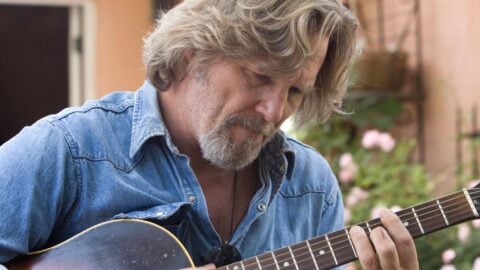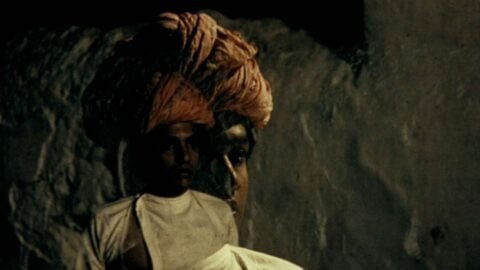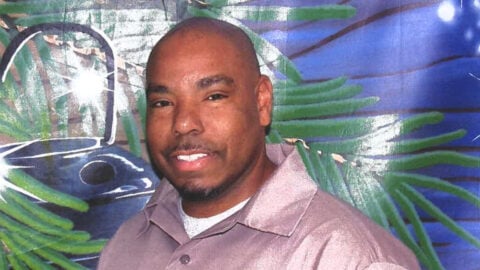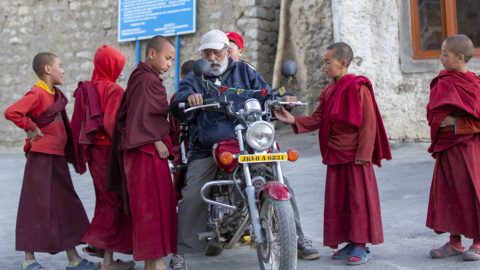Interview: Antonio Campos
Antonio Campos's Simon Killer, which opens April 5, chronicles a jilted young American’s very dark times in Paris. Campos last directed Afterschool (08) and produced Borderline Films collaborator Sean Durkin’s Martha Marcy May Marlene (11). (Durkin in turn produced Simon Killer, and the two are at work on adapting a Swedish novel for a future project.) FILM COMMENT's Jonathan Robbins spoke with Campos in depth about the film’s visceral lighting and sound design, getting hands-on with the actors, the formative influences of Haneke and A Clockwork Orange, and valuable advice from the Cambodian director of S21:The Khmer Rouge Killing Machine.

What did you have the two main actors, Brady Corbet and Mati Diop, do for their auditions?
Brady didn’t audition. He and I have known each other for four years. We met at Sundance, I was there as part of this Variety Ten Directors thing. Brady is incredibly smart, a sweet and sensitive guy. His knowledge of film is remarkable, and he is also a filmmaker himself. We worked with him on Two Gates of Sleep [10], on a short film, Mary Last Seen [10], on Martha Marcy May Marlene, now on Simon Killer, and probably something else. He’s one of my favorite people to work with because we can have conversations as director to actor, and also as two filmmakers, and he understands the camera. And he’s been acting for so long: as you find with actors who’ve been doing it since they were kids, he has this innate ability—it’s almost like they always know where they are in frame at all times. We started talking about the idea of Simon Killer on the set of Martha, and we knew that we wanted to do it right away.
I do auditions, but if I can, I prefer to just sit down and talk to someone. You know, if you’ve seen their work before. With Mati Diop [who plays Victoria in Simon Killer] I’d seen Claire Denis’ 35 Shots of Rum. When we were struggling to find an actress to play that part, Melody [Roscher, co-producer] said she was having drinks with this friend of a friend, Mati Diop. I immediately hit it off with her. And I soon found out that she’s also a director. She’s striking right away, beautiful but not in a flashy way. She had very strong opinions about the story right away.
What ideas or suggestions did they bring to their roles and to the film?
In a general way, the process was what a collaborative process should be, which is that as a director, you throw out the seed of an idea and the actors take it and make it better. For example, the guttural sounds that Simon makes, we threw that at Brady and he went with it. He was uninhibited with it, and he approached it kind of like a musical instrument—he figured out its different notes: here is angry Simon, or scared Simon, or sad Simon. And Mati would just bring a very delicate touch to everything. A lot of the film was improvised, but there are also very specific scenes that were scripted, like the scene where Victoria tells a heart-wrenching story about her past. The writing is very simple, but Mati took her time with it and the softness of her delivery.
Visually, I noticed in Simon Killer, and perhaps in Afterschool as well, shifts and modulations in the quality of the light—the shade, the brightness. How much of this is a function of filters, and how much of the lighting was ambient?
The only filter we would use is a sort of Pro-Mist—I think it’s a half or a quarter Pro-Mist. It’s just a filter that gives a softness to the frame, and cuts the edge off an HD image. But we were taking our lighting cues from the environment. Carlo’s house [where Simon stays] is very cold and minimal, and that was how we decided on that light design. And we knew that we wanted Victoria’s world to be warm, so for her apartment, we looked for one that was cozy, and we found one on the top floor of a building, the old servant’s quarters, and it was mostly wood. So there was a natural warmth and earthy quality to it. And then the night scenes in Paris, what we fell in love with was the sodium vapor lamps and that stark, raw aesthetic. We didn’t light any of the street stuff. But we cast our streets based on where the best light was. Pigalle at night is like Times Square from the Seventies and Eighties the way I know it from movies and photos. That was one of the reasons I really loved Pigalle. So, one of the most striking-looking scenes, and one of my favorite scenes in the movie, is the final confrontation between him and her. There’s almost a bluish tint on it. We were shooting the last light of the day. That was all the light that was coming in from one window—there was no light in the room itself.
The thing with the Alexa camera, it’s so sensitive, and the way that it deals with color is so nice, that my DP Joe Anderson was making the most out of the very little light that we had. We decided that we were going to use practical lights, so we tested tons of china lamps and different bulbs. We had one or two Kinos that we could use to augment things, and then we had a lot of black wrap which he would use to kind of sculpt what little light we had. We really learned that with the camera, the less you do, the better the image looks and the less digital or HD it looks. That’s the way we were approaching everything: the less-is-more school of thought.
How about the sequences with those red flares going off?
We call them light shows. In the original eight-page outline for the film I blocked out these segues where there would be something, “video” or “interstitial” or I forget what I called it. Basically I wanted to get inside the mind’s eye, of Simon. I remember when I was a kid, I would do this [Campos presses his hand against his closed eye], and you’d see lights and flickering and things like that. When you take the lens off a digital camera and you just have an exposed sensor, it doesn’t register images but it registers light. In the bottom of the brothel [where Victoria works], there were all these red Christmas lights. And I just caught in the monitor this light show.
When we came back to the States after finishing shooting, I went with this other DP Doug Emmett, another friend from NYU, whom I had just shot a commercial with. Doug and I had the Alexa for a week, so we just went to the production house where we were and spent hours shooting Christmas lights of all kinds, all colors. We stayed in this tiny little bathroom shooting, and we recycled some music we were hoping to use in the movie and then started playing around for hours with shutter speed and all that. We were hoping some lights would strobe and others wouldn’t, and try to mix it up that way.
Then we had our devices, our little things, like the pin or the references to certain things.
The pin that Simon wears?
The fox pin, yeah. There was a checklist of things that we would ask ourselves: “Is this the scene where we should introduce this or that?” We knew where we were going to go, and we knew we had all our devices or plot points or whatever you want to call them. And we would just always be working backwards from where we were. So in that way, the light show is a continuation of that, knowing we were going to find what we were looking for, so long as we were open to it happening.

There is an ominous feeling that circulates as the film progresses. Sometimes it is a feeling with a narrative payoff and sometimes not. How much was this phenomenon created by editing and how much was there from the beginning?
Movie language being what it is, I do like setup and payoff, but I do also like not using it. If what I’m doing creates too clear a meaning, so that the viewer knows just what’s going to happen when they see some kind of sequence, I don’t really like that, either. If you think about how many of the flare sequences there are in the film, it’s probably only like a minute total, and I like that. I felt like the less there was, the more it worked on a subconscious level.
What are some films or filmmakers who work with expectation and payoff in ways that you like?
For me, Code Unknown was a major film for me, and Caché, also, is huge. I mean, Haneke in general.
Benny’s Video?
Yes, Benny’s Video. But, Caché had more of an impact of me, even though Benny’s Video is pretty striking. [Bruno] Dumont. Humanité was a big film for me at the time and still is. Going back, Kubrick was the first filmmaker that I knew. Where you know, you actually know that someone is a filmmaker and that it’s a profession. A Clockwork Orange is my favorite film. So, I think there’s always been a Clockwork and Alex in my subconscious when I’m thinking about things. And Fassbinder and Bergman were huge turning points for me. Sean introduced me to Haneke and I introduced him to Bergman. We really discovered Antonioni at the same time in our Italian film class.
I think the thing I took most from Fassbinder was first that his body of work is so diverse, that it goes from weird black-and-white, absurdist surreal films to very classic beautiful period dramas to TV movies. But Satan’s Brew was one that really struck me. The Bitter Tears of Petra von Kant was one I really thought about while we were making Buy It Now [05] because of how claustrophobic it was, but Satan’s Brew really opened me up because it was so crazy and so committed to its craziness that it could go anywhere. And there’s all these really shocking gestures. You know, if someone hugs in a Fassbinder film or when someone smacks in a Fassbinder film, it always seems like it comes out of nowhere and that the characters are really feeling that moment. Even in an intimate moment, you’re getting this kind of hyperrealism.
Hyperreal, but emotionally it maybe feels somehow real.
Yes, but it’s real. Exactly. And it’s like you capture the essence of the thing which is what you’re always trying to do as a filmmaker.
Simon Killer and Afterschool also made me think about the idea of film having textures, feelable registers. Is that something you think about?
Oh yeah. All the time. When I get into a scene, one of the things I like to do is trying to figure out how to communicate something by touching the actors in a certain way. I did it on Afterschool, but I did it more on Simon, and it’s really fun for me, because I do like acting a lot. With Afterschool, it was me digging my fist into Jeremy [Allen White]’s stomach to create this discomfort for a scene where he freaks out. For Simon, I would try to find the physicality of the scene itself with the actors. Like, when Victoria’s lying on the floor and she’s kind of contorted, we spent a lot of time lying on the floor and trying to figure out where she should be to position herself so that she could stay there, and also so she could come to feel something that would bring up the performance that we wanted. I also find that if you’re having a problem with the scene, if you find something physical to change, those things then change the performance. Then there’s also smell. There’s a lot of sniffing in the film, where Simon smells things.
Oh, yes, that scene where he first meets her.
Yeah, and then in the very beginning of the film, he talks about how he knew his girlfriend was cheating on him because she smelled of sex, he smelled the sweat and latex. Then, later on when he sleeps with the other girl, he sticks his face in there and smells her, and then when he leaves he takes a big breath. And then, at the end, Victoria says “you’re pathetic, you’re a liar,” and when she moves in for the kiss, she recoils and says “you’re disgusting” because she obviously smells the girl. So there’s all this smelling and touching. There was something primal about Simon that we wanted to get out.
There’s also another way we could have done it, with close-ups on touching in specific parts, but for me it was much more a performance thing and about just trying to steer the actors into doing those kinds of gestures and letting them really sink into them. And then, in the sound design, really heightening those kinds of things. Like when the guy grabs Simon’s face, you know, really playing with the sounds of the skin touching like that, and what that really is. Even, in the beginning, there’s the sound of her where she touches her crotch when she gets naked for the first time, and there was a very specific sound we played with a lot.

And then, in both films, the screen makes itself felt. It has a physical presence, although much more so in Afterschool.
With Afterschool, there was a very clear distinction we were making between the real world and the video world and the disconnect there: the contrast between anamorphic 35mm and grainy video. Ever since I started working in video, I fell in love with its shitty quality, and when I discovered cell phone footage, I loved the impressionistic quality. And with all these different textures that make up how we experience life now. For most of history, there was one way of seeing and then, maybe sketching and painting, but now there are so many different textures and ways to see the world, and frames in which to see it. I also love feeling like you’re watching something as you’re watching it on TV, with the box and the screen and that setup, and the intimacy of that. A lot of people felt in the beginning with Afterschool, that it was like watching something you would normally watch on your own, but with a group of strangers. I think there’s a visual language that’s a little more organic in Simon than in Afterschool, but for me the main difference for Simon for me visually was fewer shots of computer screens and video monitors.
It seems like Simon comes from an upper-class background in New York. Is that right?
Yes, I think he is upper-middle class.
And the same, to some degree, with the boy in Afterschool. At least, most of the kids are pretty ritzy characters.
Well, not Rob.
But the milieu.
Yes, the milieu. Simon could have gone to that school, or a school like that on the Upper East or West Side. I guess I was surrounded by a lot of kids like that, being a middle-class kid who went to private school but was on scholarship.
Where’d you go to high school?
I went to the Dwight School. At one point, I called the school in Afterschool the Wright School. Their slogan was “If it’s not the Wright School, it’s the wrong school.” [Laughs] It was just a joke in the first treatment, and Rithy Panh, the Cambodian director [S21:The Khmer Rouge Killing Machine], was the president of the jury for a Cannes residence I did . His only note to me on the screenplay was: “This name: bad joke! Bad joke!” He could barely speak English, but he did not like that joke.
The private-school setup, or in Simon, this former private schooler goes to Paris and goes crazy setup, do you think it’s a fair criticism to say it’s basically conjuring this nightmare scenario for parents?
[Laughs]
Like these parents spend 16-hour days working to send their kids to these fancy schools, and look what becomes of them? They do drugs and go crazy.
Well, that’s what parents got so upset about with Afterschool, where they took it so personally. Anytime you make a movie about a kid, that happens. I guess one looks back a little cynically. I look back and home in on a certain aspect of adolescence and this sort of difficulty. The harder part of adolescence, especially for Simon, is the confusion of being alone for the first time and trying to figure yourself out. Of being angry, and knowing you did something wrong, but not being able to confront it. Of convincing yourself that you’re actually doing something good, but you’re not doing something good.
I don’t think I’m trying to freak parents out, but parents can be delusional. Like, with Afterschool, when I would have parents read the script and they wouldn’t let their kids come in [to read] because there’s a scene where a kid masturbates. “Well, my kid doesn’t masturbate!”
What do you see yourself focusing on, 10 years from now?
I don’t know. I’ll have different obsessions. I guess I do want to do something… I wouldn’t say lighter, but I want to find the heart in my characters. And I don’t seem to find it until I get into this heavy stuff. I couldn’t give them a nice warm ending, or some kind of redemption, for instance, for Simon, who doesn’t deserve it.







